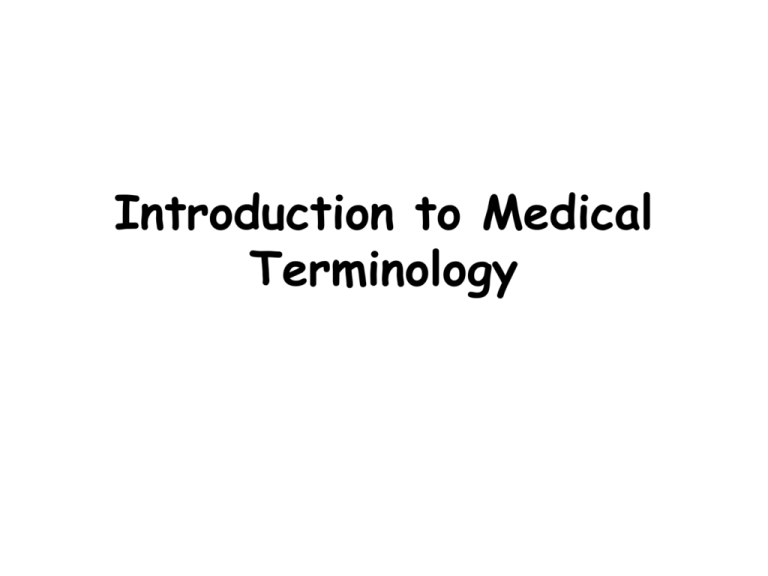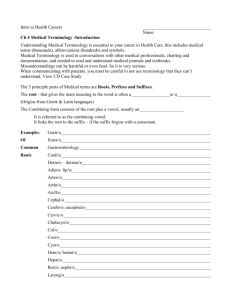Introduction to Medical Terminology
advertisement

Introduction to Medical Terminology After completing this unit, you will be able to: • Discuss the four parts of medical terms. • Recognize word roots and combining forms. • Identify the most common prefixes and suffixes. • Define word building and describe a strategy for translating medical terms. You will also be able to: • State the importance of correct spelling of medical terms. • State the rules for determining singular and plural endings. • Discuss the importance of using caution with abbreviations. • Understand the importance of confidentiality. Why take this class? Mrs. T’s top reasons to learn med terms. 10. I needed a semester class and got put in here. 9. This might be a foreign language I can actually become fluent in. 8. I might meet my future wife who is studying to become a physician and I can become a kept man. 7. I can understand what the paramedics on Chicago Fire are talking about. 6. So I can know where the doctor plans to insert the scope. 5. Mrs. Tackett is awesome! 4. If I learn and speak really big words, people will think I am very smart. 3. So I can check my hospital bill and know what they charges me $800 for. 2. I can make sure CVS gave me eye drops not ear drops. 1. I want to compete in the medical terminology event with HOSA and go to nationals at Disney. Learning medical terminology is like learning a foreign a foreign language. http://www.youtube.com/watch?v=07v53fCRzOQ Once you understand some the basic rules of how med terms are formed using word building it becomes easy. Like putting a puzzle together. It is impossible to memorize thousands of medical terms; however, once you know some basics you can break down most terms and figure out what it means. Let’s Review….. http://www.youtube.com/watch?v=ZOJrjNR7ZZM Build Medical Terms from Word Parts • Four different word parts or elements can be used to build medical terms: • 1. Word Root cardiogram • 2. Prefix pericardial • 3. Suffix carditis • 4. Combining Vowel cardiomyopathy pericarditis http://www.youtube.com/watch?v=gamvVNAoGiU Word Roots • Gives us the general meaning of the word. • Often indicates the body system or part of the body being discussed. (cardi) • May also indicate an action. (cis means to cut) Incision • May have more than one root word. (osteoarthritis) Combining Vowel/Form • To make it possible to pronounce long medical terms with ease and to combine several word parts, a combining vowel is used. Most common vowel used is o. • Combining vowels are utilized in two places: between a root and a suffix or between two word roots. When should I use a combining vowel? • Don’t use a combining vowel if the suffix begins with a vowel. • arthr -scope -it is • Do use combining vowel even if the second word root begins with a vowel. Makes it easier to pronounce. • gastroenteritis When should I use a combining vowel? • When writing a word root by itself, its combining form is typically used. Easier to pronounce. • cardi/o Do not try to memorize every medical term. Learn to break the word down into its components. Prefixes • Give information about the location of an organ, number of parts, or the time (frequency). bisubmulti- Suffixes • Attached to the end of a word to add meaning, such as a condition, disease, or procedure. -itis -pathy -algia Adjective Suffixes • Converts the root word into an adjective. Means pertaining to. -ac -al -eal -ical -ory -tic Surgical Suffixes • -ectomy • -otomy • -plasty surgical removal cutting into surgical repair -centesis = puncture to withdraw fluid thoracentesis http://www.youtube.com/watch?v=z0dCL4CHGSk -ostomy = surgically create an opening colostomy tracheostomy Procedural suffixes -meter = instrument for measuring audiometer -scopy = process of visually examining gastroscopy Interpreting Medical Terms 1. Divide the term into its word parts. gastr/o/enter/o/logy 2. Define each word part. 3. Combine the meaning of the words. stomach, small intestines, study of Pronunciation http://www.youtube.com/watch?v=tYRRb-M0hPk Pronunciation • Depending on where they are from or where they were educated, you may here different pronunciations for the same term. As long as it is clear which term is being discussed it is acceptable. • Telephones and transcription tapes can make it difficult to understand a term. If unsure, ask for the person to spell the term and read back to them the term. (RBV; TO/RBV). Spelling Spelling • It is critical that every term is spelled correct. • Even a one letter mistake can cause harm to a patient. • ileum • ilium Singular and Plural Endings • Many terms originate from Greek and Latin words. The rules for forming the singular and plural form of some words follow these languages. • Other terms follow English rules. • -a • Vertebra • Vertebrae • -ax • Thorax • Thoraces • -um • Ovum • Ova Abbreviations • Save time. • Can be confusing. • Wrong use could cause harm to patient and possible insurance processing problems. • If unsure of correct abbreviation, always write the word out. • Most institutions have a list of approved abbreviations. The Medical Record (Chart) The Medical Record • Details patient’s hospital stay. • Many medical staff write in it. • Records patient conditions, treatments, progress. • Unit clerk responsible to keep in order and add documents to it. • All pages must be signed, dated, time, have patient’s name and ID #. Parts of the Medical Record H&P Physician’s Orders Nurse’s Notes Physician Progress Notes • Consultation Reports • Ancillary Reports • Diagnostic Reports • • • • • Informed Consent • Operative Report • Anesthesiologist’s Report • Pathologist Report • Discharge Summary Electronic Records http://www.youtube.com/watch?v=qJDPAiGC28o Healthcare Settings • Acute Care or General Hospitals • Specialty Care Hospitals • Nursing Homes or Long-Term Care Faculties (LTACs) • Ambulatory Care, Surgical Centers, or Outpatient Clinics • Physician’s Offices • Health Maintenance Organization (HM0) • Home Health Care • Rehabilitation Centers • Hospice Confidentiality and Authorization • If you are asked to supply documentation related to a patient, the proper authorization must be signed by the patient. • You must sign authorization to look at your own records. • HIPAA (1996) The Health Insurance Portability and Accountability Act. HIPAA






